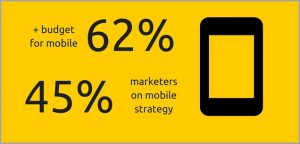Engaging social media content gets shared more often on social media.
Well yes, of course it does! We’re more apt to share content if it resonates with us, or creates an emotional connection/reaction with us. Engaged audiences are more likely to turn into customers too, so if you’re using social media for your technology marketing programs, it’s critical that your content is better than 90% of what’s out there.
Here are 5 actionable social media strategies that will help you develop your own winning social media program.
Lesson #1: Write in the second person (“you”)
Connecting with your audience is easier when you talk directly to your audience. Start a conversation, don’t just talk at them. Use the second person voice in your content to create that connection. Use “you” and “your” instead of generic terms like “clients” or “customers”, or worse yet, “I” and “we”. Your audience will appreciate that you’re speaking directly to them and become more engaged when you do so.
 Sonia Simone uses ‘you’ 14x just in the intro to her article.
Sonia Simone uses ‘you’ 14x just in the intro to her article.
Lesson #2: Go all in with images
We’ve all heard the stats about images on social media, right?
Visual content gets 94% more total views and is 40% more likely to be shared on social media networks. – Buffer Blog
 Buffer found that pinned tweets got more shares
Buffer found that pinned tweets got more shares
So why aren’t you using more images on social media? Twitter makes it easier than ever to add images to your messages, while Instagram and Pinterest are really taking off for sharing business images.
Create images more easily for social media with these tools:
- Canva has templates for all the major social media networks
- Piktochart lets you create infographics easily
- Link to images on Getty Images or use the awesome free photos on Unsplash or Pixabay
- Create custom branded images using Buffer‘s new tool Pablo.
Lesson #3: Use more power words
There are certain words that have that uncanny ability to unlock your emotions when you read them. They’ll give you goosebumps, make you feel happy or sad, or inspire you to greater action. These are the words I’m talking about when I say power words. It’s the ones that go beyond how a product is “great” or “awesome”, but tells you how it’ll save your “teetering distribution network” or how it’ll “smash through those time barriers” your customers experience. For some great lists of power words to use in your social media messages (and frankly, everywhere else too), take a look at this list, this list, and this list.

Lesson #4: Showcase your customers
Lots of tech companies don’t want to talk about exactly how they helped their customers; just that they’re working with them. That’s why they always put up the company logos of their customers, but don’t often quote them in success stories they publish.
That’s a mistake when it comes to social media. In social, it’s all about making connections with people. Yes, reaching out and connecting with the people behind the account handles and usernames. In fact, if you sound too corporate or impersonal, you’ll lose followers quickly and no one will listen to your stories.
Ask your customer support teams to find out how your customers are using your products; then write about it! Tell your followers the obstacles your customers overcame using your products. Go beyond the traditional case study and showcase your customers’ surroundings, market obstacles, challenges, and more. Revealing this information to your audience helps them identify with you since they probably face the same ones.
Square shows this through their Square Stories series of videos on YouTube. They’re short videos of Square customers explaining how they’re using the product in their business. There’s everything from retail shops to restaurants and even a pediatrician, Dr. Nash of 1-to-1 Pediatrics.
Lesson #5: Write in smaller chunks
On Twitter, you’re forced to be brief, since you only have 140 characters to play with. But other social media platforms give you a much longer space to write in. Avoid the temptation to fill it up. That’s because as readers we love to scan, and not read. This applies to all social media, including the business blog.
- On the blog, keep paragraphs between 3 and 4 lines each, regardless of how many sentences you’ve written.
- On Twitter, stick to around 75 characters, so you’ll have space for the URL of any images you’re sharing.
- On Instagram and Pinterest, let your images do the talking. Put short chunks of text on the images, and write only a couple of sentences for the caption.
Today’s marketer is creating content at a staggering rate. There’s no way for us to read it all. Give your content the best chance possible at being read and shared by using these 5 lessons in your next social media program.
(136)








